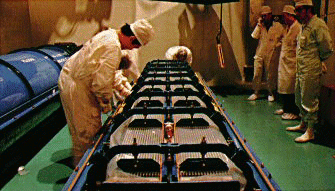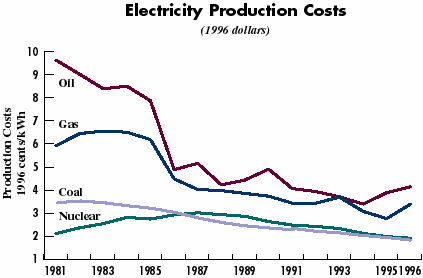Why use Nuclear Power?
Several major reasons that people working in the field still remain
optimistic about nuclear power are:
- the energy produced per amount of material consumed is the highest
available
- costs are competitive with coal, the major source used in the world
- uranium, the source material, is abundant
- plutonium, a by-product of commercial nuclear plant operation, can also
be used as a fuel
- the amount of waste produced is the least of any major energy production
process
- nuclear energy provides benefits other than electricity generation.
Energy Production Rates
Uranium-235 is the isotope of uranium that is used in nuclear reactors.
Uranium-235 can produce 3.7 million times as much energy as the same amount of coal. As an
example, 7 trucks, each
carrying 6 cases of 2-12 foot high fuel assemblies, can fuel a 1000
Megawatt-electrical (MWe) reactor for 1.5 years. During this period, ~ 2 metric tons of
Uranium-235 (of the 100 metric tons of fuel - uranium dioxide) would be consumed. To
operate a coal plant of the same output would require 1 train of 89-100 ton coal cars each
EVERY day. Over 350,000 tons of ash would be produced AND over 4 million
tons of carbon dioxide, carbon monoxide, nitrogen oxides and sulfur oxides would be
released to the environment.
Typical Container with 2 Fuel Assemblies

Energy Production Costs
The best example of cost comparison is shown by this graph provided by
the Nuclear Energy Institute that compares average nuclear and coal production costs over
recent years. Nuclear fuel costs are considerably less than coal. However, various
capital, operating and maintenance costs for coal may be lower than nuclear. Thus, the 2
costs are comparable.
 Courtesy NEI
Courtesy NEI
The various components of energy generation account for the following:
- Capital costs to build the plant and modifications after the plant is
built
- Ongoing operation and maintenance costs
- Fuel costs
- US Department of Energy (US DOE) charges for ultimate spent fuel disposal
- US Nuclear Regulatory Commission (US NRC) charges for regulation
Typically, the plant capital expenses are depreciated over 30 to 40
years. Modifications are depreciated over the remaining life of the plant (usually taken
as the end of the current license). The operating and maintenance costs and US DOE and US
NRC charges are accounted for as an annual expense. Fuel costs are usually treated
separately as a capital expense depreciated over a number of years.
Related pages and figures provided on the site are:
Base Materials Abundant
Uranium ore is used as the raw material to make the uranium fuel.
Primary source countries are - United States, South Africa, Australia, Canada, Nigeria -
with resources between 270 and 2400 thousand tons each. Other countries having uranium
mineral resources with estimated resources of between 36 and 124 thousand tons each are -
France, Argentina, India, Algeria, Gabon, Brazil. [R.A. Knief, Nuclear Energy
Technology, Hemisphere, 1981]. Since the end of the Cold War, a number of former
Soviet Bloc countries as Russia, Kazakhstan, and Uzbekistan have entered the world market
as suppliers.
Related figures from the Energy Information Administration's 1998
Uranium Industry Annual Report are:
The uranium ore must go through several steps before it can be placed in
a reactor:
- Mining to excavate or extract the ore
- Milling to produce U3O8 , which is also called yellowcake
- Conversion - a 2 step process to purify the yellowcake and produce
uranium hexafluoride
- Enrichment of the uranium-235 portion from 0.7 % as found in nature to 3
to 5 %. Processes used are gaseous diffusion or gas centrifuge. These separate the heavier
U-238 from the U-235.
- Formation of a ceramic uranium dioxide
- Cladding the fuel with zirconium alloy
Plutonium Byproduct of Reactor Operation
95 to 97% of the fuel in the reactor is uranium-238. Some of this
uranium transforms into Plutonium-239 and Plutonium-241 - usually about 1000 kg form after
a year of operation. At the end of the cycle (a year to 2 years,
typically), very little uranium-235 is left and about 30% of the power produced by the
reactor comes from the plutonium.
To some, the plutonium is viewed negatively as the stuff bombs can be
made from. To others, plutonium is a resource we need to make use of. Based on DOE
projections of fuel assemblies that will be discharged as spent fuel through the year
2030, there would be enough plutonium present in the U.S. spent fuel assemblies to operate
20 reactors for 40 years each. Plutonium-239 decays very slowly (half life is
24,110 years). Thus, this
is a resource if the reprocessing option is selected in the future. It should also be
pointed out that some of the plutonium byproducts formed during the reactor operation,
e.g. Pu-240, do reduce the effectiveness of plutonium as a bomb material by forcing more
specialized separation of the Pu-239 isotope.
Countries that have civilian reprocessing facilities (operational or
under construction) capable of separating plutonium are - France, India, Japan, United
Kingdom, Russia as shown by the Nuclear Control Institute figure below.
 Courtesy
NCI
Courtesy
NCI
Low Quantities of Waste
The fuel assemblies remain in the reactor for 3 to 5 years. The waste,
in the form of the radioactive fission products, remains inside the fuel. As noted above
about 2000 kg are converted to waste after 1.5 years of operation. Currently, the fuel
assemblies remain in cooling pools for about 10 to 15 years. After that time, they are
being transferred to special casks for storage where air can be used to cooling. The
reduction in radioactivity and thermal levels for the spent fuel are illustrated by the US DOE figures below.

To extract the waste and plutonium from the fuel can result
in the generation of liquid wastes since currently nitric acid is used to breakdown the
cladding material and the ceramic into solution. The liquid and spent fuel wastes are very
radioactive initially. However, these levels also drop as shown in the above figures.
Applications of Nuclear Energy other than Electricity Generation
Radioactive materials, produced in reactors, are used in diagnostic and
therapeutic treatments in medicine, weld inspection (radiography), power sources in remote
locations and space applications, and food irradiation.
Copyright © 1996-2011. The Virtual Nuclear
Tourist. All rights reserved. Revised:
Friday April 01, 2011

 Courtesy
Courtesy  Courtesy
Courtesy
